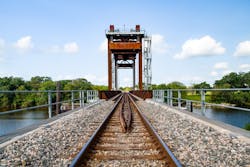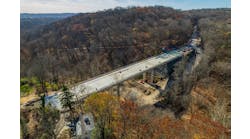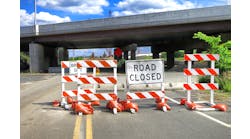By: Ted Zoli, P.E., and Kary Witt, P.E., HNTB Corporation
Toll bridges often serve as the economic engine for an entire community’s transportation system. Work on these bridges that interrupts traffic flow inevitably affects toll revenue, which can have long-lasting ripple effects on the delicate transportation ecosystem. That’s why it’s so important to plan, design, and engineer toll bridge repairs and replacements strategically.
Economic impact
Many toll bridges fund other transportation modes in their region, either along the same corridor or in completely unrelated areas. About 45% of toll revenue from the Golden Gate Bridge, for example, subsidizes two transit systems that have a significant impact on congestion along the same corridor. The Delaware Memorial Bridge, on the other hand, funds the Cape May-Lewes Ferry, which is hours away, along with the regional airport. The Pennsylvania Turnpike Commission—with more than $1 billion in annual toll revenue—provides $450 million per year to fund transit in that statewide program.
Keeping toll revenues coming in also has broad effects on transportation financing. Imagine a toll bridge that fails to meet its revenue projections or fails to maintain a state of good repair. These missteps can negatively impact the agency’s ability to borrow money, which results in additional user costs (tolls) in order to maintain state of good repair and to meet commitments to regional programs which they support.
As a result of these dependencies, working on a major toll bridge is like doing heart surgery. The organ is critical to the entire system. When you need to repair it, you have to do it in a way that allows the heart to keep pumping to support the rest of the body. Taking a major toll bridge out of service is a last resort and can only be done for a limited period of time without significant damage to the rest of the ecosystem that depends on this revenue. Adhering to best practices can help keep the transportation ecosystem humming and keep revenue flowing when replacing and repairing toll bridges.
Accelerated bridge construction minimizes revenue disruption
Toll bridges are a perfect case for accelerated bridge construction (ABC) . At the core of ABC is the acknowledgment that traditional processes for bridge replacement can take a significant amount of time and adversely impact the social and economic wellbeing of nearby communities, along with disrupting toll revenue.
Replacing a heavily used span over a river, for example, might traditionally demand the closing and removal of the existing bridge, followed by the building of a new one—a process taking years. In addition to the obvious loss of toll revenue, commuters would have to log thousands of extra miles and endure delays due to detours and congestion. Commercial transportation efficiency would suffer, and emergency services could be hamstrung. On the jobsite, workers would spend more months exposed to construction and vehicular risk, and opportunities for labor and material cost overruns would increase.
Instead of adhering to a traditional, sequential approach, ABC allows bridge owners to perform a range of activities concurrently and in controlled environments, so they can more efficiently design, procure, prefabricate, and erect replacement bridge systems. In most cases, they create the replacement bridge offsite or adjacent to the existing structure, then transport it to the final location and secure it in place. Construction is faster, and the replacement activity itself can happen in as little as a few days, or even hours.
Lane-by-lane repairs maintain traffic flow
Another strategy to minimize the revenue effects of toll bridge repairs is to plan the construction around lane usage. This can include repairing one lane at a time and carefully staging the work to minimize the number of moves the commuter is required to make during construction. On the upcoming Verrazzano Bridge repair project in New York City, for example, the team designed a traffic control scheme that moves the work zone barriers across two lanes twice a day to maintain four lanes of traffic in the peak direction for both morning and evening commutes. Contractors can spend as much time on work zone safety as they do in construction; for this reason, work zone traffic management is integrated into the contractor’s responsibilities and is fundamental to every aspect of executing the work.
Speed gains are multiplied
Given the high volume of traffic and the need for throughput during the peak commute, only one lane can be repaired at a time. Any time savings within a stage is multiplied through each subsequent stage. Given seven lanes on the upper level for the Verrazzano Narrows bridge, a week in time savings equates to saving seven weeks of disruption to traffic and complex traffic staging. Every effort expended to increase the speed of repairs using ABC pays significant dividends to the toll authority and to the traveling public. For example, the Verrazzano project will use prefabricated deck reinforcement cages and internally cured high-performance concrete that reduces the curing time from 14 days to seven. Across seven lanes, that change removed more than two months from the repair schedule.
Off-peak timing keeps traffic flowing
Another seemingly obvious strategy for accelerating the work and minimizing customer inconvenience is to do it during off-peak hours. This can include nighttime, weekend and holiday closures, when the effects on workplace commuters—and toll revenues—can be minimized.
Customized equipment allows work without closures
Customized work platforms and other equipment can minimize lane closures and improve safety, as well. In metropolitan New York, for example, contractors used a specially designed gantry crane that spans the entire roadway, rather than being driven onto the bridge deck itself. This allowed for cars to pass under the crane, so work could continue during active traffic. This technique also was used to redeck the Walt Whitman Bridge in Philadelphia.
Maintaining customer communication is critical
Tolling agencies have a unique business relationship with their customers. Unlike other DOT systems, tolling authorities have direct financial transactions with their customers on a daily basis. And keeping them satisfied can affect revenues for the region’s entire transportation system.
For that reason, toll operators put a tremendous amount of emphasis on communication with customers during any tolled bridge repair or replacement project. Tolling authorities are encouraged to engage in consistent, ongoing communication about closures, slowdowns and alternate routes. Thanks to electronic tolling systems like FasTrak and E-ZPass, they can communicate with most regular users directly. They also work with the news media and staff up during repairs to answer phone inquiries.
With federal funding continuing to decline, tolling is becoming even more critical to maintaining the nation’s transportation infrastructure. Efficiently keeping tolled bridges and roadways in a state of good repair and strategically planning replacements is simply essential to many communities.
About The Author: Witt is a national toll market practice leader at HNTB and former manager of the Golden Gate Bridge. Contact him at [email protected]. Zoli is HNTB’s national bridge chief engineer. Contact him at [email protected].



